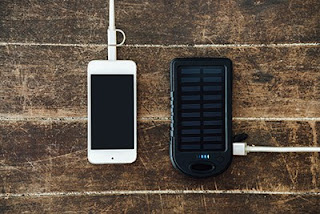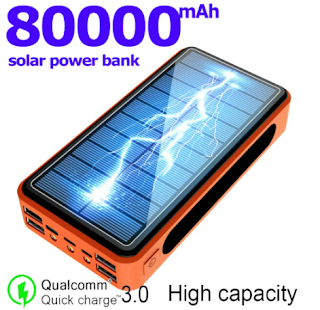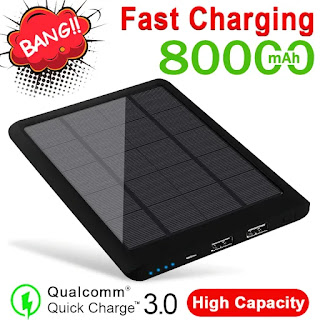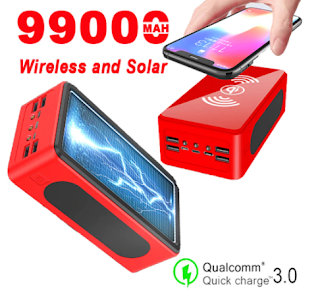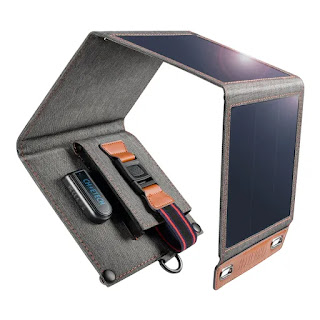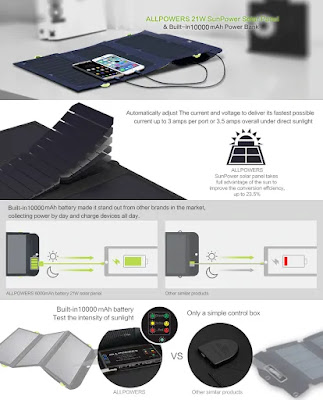In this article we provide a brief background on batteries and battery chargers to introduce you to the more recent and environmentally friendly technology associated with solar battery chargers. We also provide examples of different battery chargers that use solar energy.
Wait...
If you are looking for solar systems, with Ether elastic technology, then take a look at this:
Solar Radiant Energy: Ether Elastic Technology
✔ The space itself is the loss of inertia of the dielectric. Faraday: Loss of inertia dielectric produces a magnetic field.
✔ So, the smaller the space, the higher the capacitance
✔ The dielectric is a stress of the Ether, which is elastic. It allows inductive propagation light.
✔ A technology that stimulates Ether elasticity, with resonance, produces free energy:
✔ Pull in infinite energy from the sun with Ether elastic technology
✔ In essence, this is a version created from the original Nikola Tesla version: Radiant energy
Solar Battery Chargers Are Environmentally Friendly
Batteries were invented around 1800. A battery combines one or more electrochemical cells which store energy. This energy can then be changed into kinetic energy in order to create electricity. Batteries have become so ubiquitous that we rarely think about how central they are to daily life. We use batteries in flashlights, watches, cameras, laptop computers etc. Batteries can be found in the home and in business. Makers of batteries include Energizer and Duracell and the battery industry generates billions of dollars in revenue.
Unfortunately, until the late 20th century batteries were disposable and sat in landfills where they leaked toxic chemicals. In order to alleviate environmental harm and to reduce the cost of purchasing single use batteries, battery chargers came to market.
Battery chargers put energy into a rechargeable battery by transferring a current through it. The current's charge varies depending upon the technology and size of the battery. For example, we use different rechargeable batteries and chargers for laptops than we do for golf carts. Because of the widespread use of nickel cadmium high-power batteries that power electronics such as digital cameras, battery chargers have become more popular; they can now be found in almost any electronics store. The demand for chargers has even has stores such as CVS, Target, and Wal-Mart selling them.
According to Energy Star, a government program that promotes energy efficiency, about 230 million products use battery charging systems in American homes and businesses. Energy Star promotes energy-efficient battery chargers and estimates that Americans could save over 1,000,000,000 kilowatt hours of energy per year if they used more efficient chargers.
Promoters of solar chargers point out that even more energy can be saved if the sun's power is harnessed to recharge batteries: battery chargers can also use solar energy to force an electric current into the battery. As the market for solar products have grown, we have seen corresponding growth in the solar battery charger market.
What Is A Solar Battery Charger?
A solar charger is a device that uses sunlight to generate electricity.
This electricity is then used to charge electrical devices which can include but are not limited to: cell phones, laptops, car batteries, reading lights and personal fans. Because these chargers do not have the ability to directly expel electricity into the devices, an extended-life battery pack is included within the device. This way, the electricity that the solar cells generate are stored in the battery and available to discharge through the use of a charging supercapacitor at a later time. This charging supercapacitor is the key to being able to charge devices on demand even if the charger is not in direct sunlight at the time of use. These solar chargers can range in size from fitting into the palm of your hand all the way up to the size of a picnic table to be used for charging larger things such as an RV battery.
What is the best solar battery charger?
- Top 5 Solar Battery Charger recommended, and "best category"
Below is a list of the Solar Battery Charger categories to choose from, and the recommended 5 categories. I can call the Top 9 categories, or the 10 best Solar Battery Charger categories. The number is not necessarily. Therefore, you need a separate courage to choose for yourself.
1. 80000mAh Solar Power Bank Portable Charging 4USB Output Port Battery Pack PowerBank for Xiaomi Samsung IPhone
Solar charging is designed for emergencies, not a primary source of charging due to the compact solar panel size and sunlight intensity, it could take 21 hours under direst strong light to fully charge(there are 7-8 hours of sunlight per day). So we highly recommend charge the solar charger via an adapter or computer, which only take a few hours.
2. 80000mAh Solar Power Bank High-capacity Portable Phone Fast Charger Powerbank Solar Battery Panel for Xiaomi Samsung IPhone
Normally, it can reach 25% battery after 5 hours recharge under strong sunlight, so only the first light will on.
The water drops are good, but please don't immerse in the water for too long.
3. 99000mAh Solar Wireless Power Bank Portable Charger Large Capacity 4USB LEDLight Outdoor Fast Charging for Samsung Xiaomi Iphone
Please charge it under STRONG sunlight, do not charge it in cloudy day or the place through glass(e.g a window or car)
4. CHOETECH Solar Charger 14W USB Foldable Phone Travel Charger With SunPower Solar Panel Waterproof For iPhone X/8/7/6s/Plus
Exclusive Smart Charging:
Charge compatible devices at up to 5V/2.1A when under direct sunlight. Convert up to 21.5-23.5% of solar power into free energy with highly efficient sunpower solar panel.
Ultra Compact:
It’s 5.8* 6*2.1in when folded. Foldable design makes it ultra compact and ready for travel, just slip it into the bag and go out whenever you like.
Incredibly Durable:
Constructed with four solar panels with waterproof nylon, this usb solar charger offers weather-resistant outdoor durability. And two eye-holes on the side allow easy attachment to backpacks, trees or tents.
Wide Compatibility:
Works for most of devices that require 5V power. You can charge iPhone, Android smartphones, tablets and other USB-charged devices. Energy-saving and environmentally friendly, the charger will keep USB-powered devices charged up while travelling.
5. ALLPOWERS Portable Solar Panel USB 5V 21W Built-in 10000mAh Power Bank Foldable Solar Battery Charger for iPhone iPad Xiaomi
Built-in 10000mAh Battery
The first and the only solar panel brand with built in battery on AliExpress. Store energy and supply power to your device whenever, most solar panels can not be used at night in market.
Exclusive Charge Technologies
Dual USB-A & one USB-C fast charging, its fastest possible current up to 3Amps per USB port and 3.5Amps in total; 2A input, recharged by solar or wall charger
Advanced Safety
FCC, RoHS, CE certified; Short circuit, surge protection technology and high temperature treatment keep you and your devices safe.
Best of all: Ether technology - homemade solar chargers, and especially home-made solar systems
Hidden solar technology revealed after 20 years
The following
video shocks you!
Hidden technology has surfaced from the bottom of the ocean.
A scuba diver working for US government stole the patents
of a nano solar cell (half of an inch square), capable of generating
the same amount of electricity as a full-size solar panel.
Check out the following free video presentation to learn what
Solar Battery Chargers Buying Guide
The first thing to do when selecting a solar charger is to understand what your power needs are so you can purchase a charger that will not be too weak for your needs or too large (and too expensive) for your needs. The objective is to select one that can handle your equipment so you are not disappointed with actual run times and charging times. Equally it is not necessary to purchase one that can run a refrigerator and cost a lot of money when you only need to charge a cell phone or camera battery.
So, the first step is to take an actual inventory of the equipment and devices you want to charge with your new solar charger. We recommend making a list. On your list you should also indicate how many watts or amps your equipment draws when in use and for how many hours per day you will need to run those devices. For an example your list should look something like this:
Equipment needed to run with Solar Charger:
Cell phone 5 watts or 400 mah. Hours needed per day: 5 hours
Laptop Computer 50 watts or 4000 mah. Hours needed per day: 3 Hours
Ok, so now that we know what our actual power needs are, we are ready to select your battery charger. Based on the above example you can take the number of hours needed times the amps for total amp hours needed per day for that device.
Example:
Cell Phone 400 mah x 5 hours = 2000 mah needed per day to run your cell phone.
Laptop Computer 4000 mah x 3 hours= 12000 mah needed per day to run your Laptop.
Total Power needed: 14000 mah (or 14 amp hours) a day to run your devices.
Now we know that we need 14 amps out of a solar battery charger daily to meet your needs. Since you have high power needs a backup battery will be required with your solar charger system. With a back up battery you can store power from your solar charger inside the battery and then run your equipment right off the battery. The specification to look for on our site is the battery size, which will be defined by amps. You will need at least a 14-amp battery in order to run your equipment for the hours per day you specified.
You are probably wondering how many hours will it take to charge a 14-amp battery with a solar battery charger? The answer is quite simple: A 1 amp solar charger will charge up a 14-amp hour battery in 14 hours. Simply take the amp hours of the battery and divide it by the amperage output of the solar charger. Example: 14 amps divided by 1 amp = 14 hours. If you want to reduce those charging times simply pick a more powerful solar charger.
*Please note: If you do not have the amperage specification handy simply take the watts of your device divided by 12 to get the amps. Example: 5 watt cell phone divided by 12 = 0.400 (or 400 mah) Now you know your cell phone requires 400 mah per hour to run. If you just need to run a cell phone most solar chargers generate 400 mah an hour to run your cell phone with out back up battery. While shopping at Earthtech Products simply look for solar chargers that generate 400 mah per hour. This information can be found in specifications on the products detail page.
